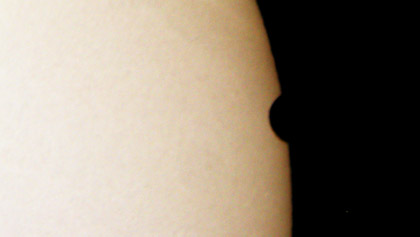The secret to amateur astronomy is to manage your expectations. The Whirlpool Galaxy in the eyepiece? Don't expect more than a glowing smudge. The greatest comet since Halley's? Don't bet on it. The first transit of Venus in 122 years? It will probably be cloudy.
So after waking up before dawn and driving 45 minutes to where my friends and I planned to watch the transit, no one was particularly surprised to see a dense fog covering the ground and low clouds threatening rain. Fortunately, New England weather can change suddenly, and after waiting an hour or so, we could see the clouds thin and the fog lift slightly.
Still, we were all taken by surprise when we saw the sun. The veil of mist at the horizon shifted with the wind and suddenly we could see the sun's pale disk. Dimmed by the fog, we could briefly look at the sun with unprotected eyes, and we all saw it at once: a great big dot was crawling across the sun's face. We are so used to the perfect and pure sphere of the sun that seeing this blemish made me realize how scary eclipses must have seemed a thousand years ago.
Then the clouds lifted and the blinding light of the sun shone on us again, and we scrambled to look through the telescope, already protected by a solar filter, to get a better look. The view did not disappoint. The silhouette of Venus was sharp against the glowing surface of the sun, and it looked huge next to the few sunspots that marred the sun's disk. We took turns at the eyepiece, watching Venus slowly march across the sun, until the last sliver faded and the sun was perfect and pure once again.

